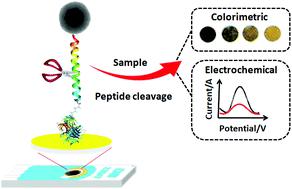Our official English website, www.x-mol.net, welcomes your feedback! (Note: you will need to create a separate account there.)
A dual electrochemical/colorimetric magnetic nanoparticle/peptide-based platform for the detection of Staphylococcus aureus.
Analyst ( IF 4.2 ) Pub Date : 2020-05-26 , DOI: 10.1039/d0an00673d Shimaa Eissa 1 , Mohammed Zourob
Analyst ( IF 4.2 ) Pub Date : 2020-05-26 , DOI: 10.1039/d0an00673d Shimaa Eissa 1 , Mohammed Zourob
Affiliation

|
Point-of-care facile and economical detection of Staphylococcus aureus (S. aureus), one of the main causes of food-borne illness, is highly demanded for the early diagnosis and control of infections. Herein, inspired by the proteolytic activity of S. aureus protease on a specific peptide substrate, we developed a rapid, simple and cost-effective biosensor for S. aureus using dual colorimetric and electrochemical detection on the same platform. In this approach, gold screen printed electrodes were used on which specific peptide sequences coupled to magnetic nanoparticles were immobilized giving the black color of the sensor surface. The addition of the S. aureus protease solution on the electrode surface causes cleavage of the peptide sequence and the release of the magnetic nanoparticles revealing the golden colour of the electrode which can be easily seen by the naked eye. Furthermore, square wave voltammetric signals can be detected on the same electrode in the ferro/ferricyanide redox couple. The change in the peak current after peptide cleavage was directly proportional to the concentration of S. aureus. The detection limit of the electrochemical assay was 3 CFU ml−1 after 1 min. Moreover, the biosensor was capable of specifically distinguishing S. aureus from other food- and water-borne bacteria such as E. coli and Listeria using the dual mode colorimetric and electrochemical detection. The biosensor was also tested in spiked milk and water samples showing very good recovery percentages. Thus, we believe that this dual mode biosensing platform enables the easy and accurate determination of S. aureus and holds great promise for point-of-care diagnosis.
中文翻译:

基于双电化学/比色磁性纳米颗粒/肽的平台,用于检测金黄色葡萄球菌。
对食源性疾病的主要原因之一的金黄色葡萄球菌(S. aureus)进行现场即时且经济的检测对感染的早期诊断和控制提出了很高的要求。在此,受金黄色葡萄球菌蛋白酶在特定肽底物上的蛋白水解活性的启发,我们在同一平台上使用双重比色和电化学检测技术开发了一种快速,简单且经济高效的金黄色葡萄球菌生物传感器。在这种方法中,使用了金丝网印刷电极,其上固定了与磁性纳米颗粒偶联的特定肽序列,从而产生了传感器表面的黑色。添加的金黄色葡萄球菌电极表面上的蛋白酶溶液导致肽序列的裂解和磁性纳米颗粒的释放,揭示了电极的金色,这可以用肉眼轻易看到。此外,可以在铁/铁氰化物氧化还原对中的同一电极上检测方波伏安信号。肽裂解后峰值电流的变化与金黄色葡萄球菌的浓度成正比。1分钟后,电化学测定的检测极限为3 CFU ml -1。此外,该生物传感器能够将金黄色葡萄球菌与其他食源性和水源性细菌(如大肠杆菌和李斯特菌)区分开来使用双模比色和电化学检测。还对加标的牛奶和水样品中的生物传感器进行了测试,显示出非常好的回收率。因此,我们相信这种双模式生物传感平台可以轻松,准确地确定金黄色葡萄球菌,并为即时诊断提供了广阔的前景。
更新日期:2020-06-29
中文翻译:

基于双电化学/比色磁性纳米颗粒/肽的平台,用于检测金黄色葡萄球菌。
对食源性疾病的主要原因之一的金黄色葡萄球菌(S. aureus)进行现场即时且经济的检测对感染的早期诊断和控制提出了很高的要求。在此,受金黄色葡萄球菌蛋白酶在特定肽底物上的蛋白水解活性的启发,我们在同一平台上使用双重比色和电化学检测技术开发了一种快速,简单且经济高效的金黄色葡萄球菌生物传感器。在这种方法中,使用了金丝网印刷电极,其上固定了与磁性纳米颗粒偶联的特定肽序列,从而产生了传感器表面的黑色。添加的金黄色葡萄球菌电极表面上的蛋白酶溶液导致肽序列的裂解和磁性纳米颗粒的释放,揭示了电极的金色,这可以用肉眼轻易看到。此外,可以在铁/铁氰化物氧化还原对中的同一电极上检测方波伏安信号。肽裂解后峰值电流的变化与金黄色葡萄球菌的浓度成正比。1分钟后,电化学测定的检测极限为3 CFU ml -1。此外,该生物传感器能够将金黄色葡萄球菌与其他食源性和水源性细菌(如大肠杆菌和李斯特菌)区分开来使用双模比色和电化学检测。还对加标的牛奶和水样品中的生物传感器进行了测试,显示出非常好的回收率。因此,我们相信这种双模式生物传感平台可以轻松,准确地确定金黄色葡萄球菌,并为即时诊断提供了广阔的前景。



























 京公网安备 11010802027423号
京公网安备 11010802027423号